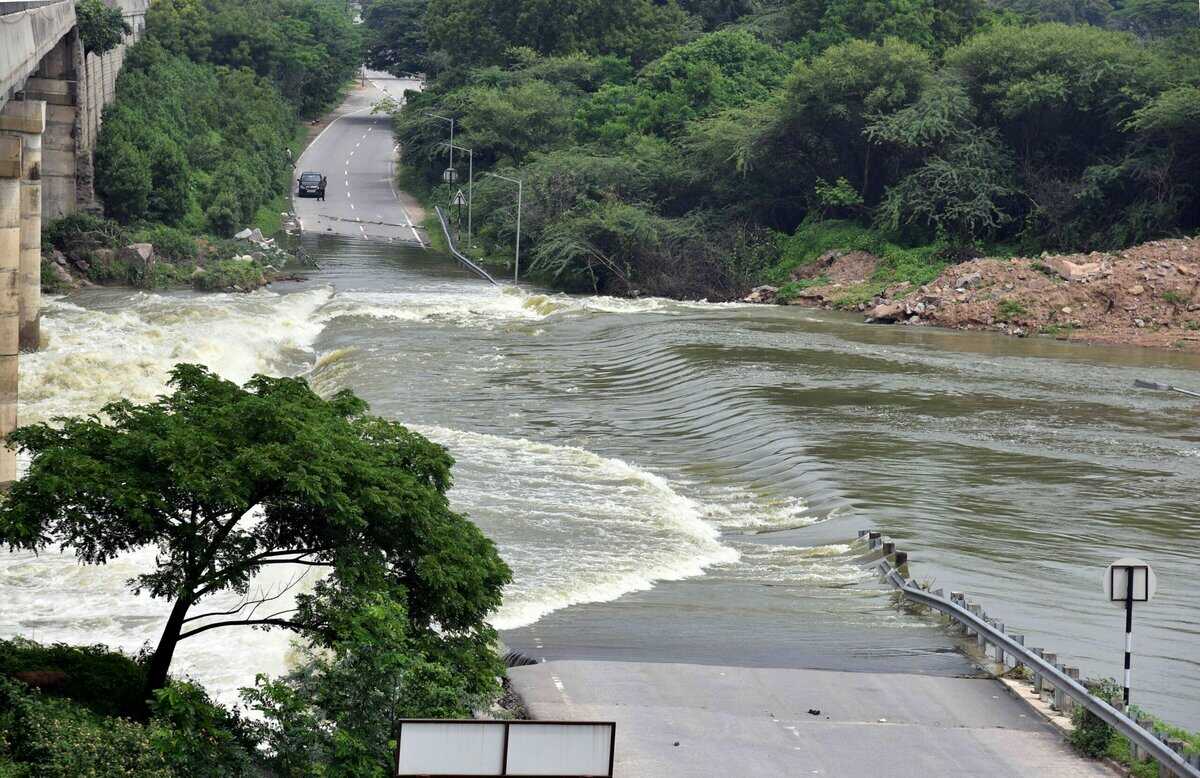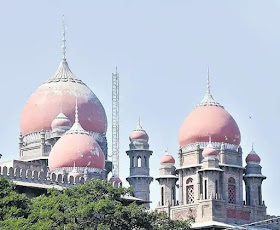
Hyderabad: Over the past week, many gates of the Osman and Himayat Sagar reservoirs have been lifted to release excess rainwater once both the lakes were full. As a result, several homes built on the downstream riverbed of the Musi river have been flooded, and thousands of people have been affected.
The activists here in Hyderabad also are opposing the release of water from both the lakes in the Musi river before the water reaches the Full Tank Level (FTL). In fact, due to heavy rains water was released from the Himayat Sagar for the third consecutive year this time since 2020. That it was released in 2010. Similarly, water from the Osman Sagar was released for the second consecutive year.
Sarwat complained that the present FTL marked by the authorities is due to the shrinkage of the water bodies. “The storage capacities are down due to vast encroachments in Himayat Sagar and Osman Sagar by the land mafia,” she added. The Musi river runs across a 50-kilometre-odd radius around Hyderabad and has been more or less turned into a sewer today.
Several illegal constructions in catchment areas – Fact Finding report
With the help of a report of a fact-finding visit, Sarwat stated that there were constructions, compound walls, fences and vast land stretches inside the FTL boundaries of both lakes. FTL pillars of HMWS&SB had been found uprooted, she claimed. “The authorities must take up dredging of landfills inside the FTL boundaries and remove all encroachments. Both Osman Sagar and Himayat Sagar, which are tributaries of the Musi river, must be brought back to their original water holding capacity, she added.
A total of 84 villages in Shamsabad, Moinabad, Chevella, Rajendernagar, mandals mainly fall in catchment areas as per the now revoked G.O 111. In recent years, a lot of real estate activity started in these mandals with ventures coming up on acres of land. Plots have also been sold for villas and farmhouses and other developmental activities near the Osman Sagar and Himayat Sagar. What is happening is ironic, given that these two lakes are supposed to protect Hyderabad from the Musi river during rains.
Realtors were waiting for GO 111 or be scrapped
Realtors from and around Hyderabad were confident that the state government revoke GO 111. It finally happened this year and has paved the way for a real estate boom. With that, as more construction happens, rainwater will fill up the Osman Sagar and Himayat Sagar sooner. That will lead to the water board having to release water into the Musi river sooner. Finally, homes on riverbeds of the Musi in Hyderabad will be frequently flooded.
The Himayat Sagar feeds on the river stream Esa while the Osman Sagar on the river Musa (both together meet at Tipu Khan bridge, and are hence called Musi). Very few people are aware that Esa is the tributary of the Musi river and that it originates somewhere near Pargi. Musa river originates from Vikarabad at Ananthagiri Hills, about 90 kilometres from Hyderabad.
Compared to the catchment areas around Osman Sagar, there are more encroachments around Himayat Sagar. It is higher in the Shamshabad mandala, said, activists. If water is not released from Himayat Sagar due to rains, colonies in Shamshabad are likely to get submerged. Rainwater from Muchintala in Shamshabad also makes its way to the Himayat Sagar. Similarly, the water from Moinabad mandal and Shankarpally mandal makes its way to Osman Sagar.
Both the reservoirs were constructed by building dams on the Musi (also known as Moosa) river and Esa River to protect Hyderabad from floods. The proposal to build the dams came after a major flood during the reign of the sixth Nizam Mahbub Ali Khan (1869-1911) in 1908, in which more than 15,000 people were killed.
Recently the Telangana government revoked GO 111 as it was felt Hyderabad no longer depends on these two reservoirs for water supply. Hence, it said that there was no need to continue with the restrictions on development in the catchment radius of the Himayat Sagar and Osman Sagar, both of which are tributaries of the Musi river.
Hyderabad’s drinking water requirement has increased to more than 600 million gallons per day (MGD). It is being drawn from other sources including the Krishna River. Water from the Osman Sagar and Himayat Sagar reservoirs amounts to just about 1 percent of the daily requirement.
Activist Dr Lubna Sarwath, who is also the president of the Water Resources Council, said that before the government revoked GO 111, there were already over 10,000 illegal constructions around the two lakes. The Osman Sagar and Himayat Sagar, along with several other smaller water bodies in Hyderabad, are victims of real estate encroachments. The riverbed of the Musi river has also been occupied by thousands of people now, many of whom have built cement homes.
As per the EPTRI Study Report of 2007, inflows into the Osman and Himayat Sagar lakes were dwindling. Both had become defunct for a while, as the Musi river continued to work as a sewer for Hyderabad. Many times both lakes have dried up ( reduced to their ‘dead storage levels’) due to massive obstructions and diversions of inflows due to the construction of check dams/water harvesting structures. There are more than 28000 such structures in number for the 2 lakes in their entire catchment areas.
‘Govt should act’
However, with unprecedented rainfalls over the last three years, inflows have sharply increased into the Osman and Himayat Sagar. “Had the authorities prevented encroachments and illegal structures in the catchment areas, it would not have been this way. The government should have protected small water bodies that stored water as well. Then the situation would not have been so bad for colonies on the river bed of the Musi river,” points out another activist.
With doors of the Musi River being opened like never before in the last 20 years, low-lying areas are getting inundated across Hyderabad. The city administration itself is not aware of the magnitude of the damage it might cause. Several areas alongside the Musi River at Chaderghat, Moosarambagh, Nagole and beyond bear brunt of the disproportionate release of water.







































